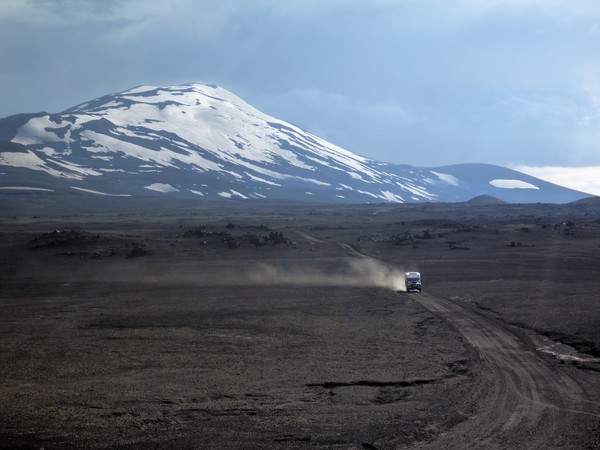Contrary to the advice of pretty much everyone that has seen it, I went to see Prometheus at the weekend. A big reason for going was that I knew they had filmed part of it in Iceland. I had seen the film crews when I was working in the Hekla area last summer and I was curious to see how it looked on the big screen.
In the film, a spaceship lands upon the black rocky surface of a distant planet. The door opens and the crew drive off across the dusty waste to the alien base, with huge mountains towering above them on all sides.
How much of this is Iceland?

Futuristic all-terrain vehicles race across the dusty landscape of a distant and unfamiliar planet. Steep, dark peaks rise menacingly in the background.
Answer: The soil.
Only the soil is Iceland. A jagged lava flow (aa, or slabby-pahoehoe) covers the floor of the valley, and has since been partly-buried by repeated eruptions of ash and pumice from Hekla.
Everything above the flat plain is computer trickery.
A real-life active volcano

An old landrover races across the dusty landscape of our very own planet, Earth. Hekla rests peacefully in the background.
A look at real-life Hekla shows the part-buried lava landscape. It looks like the dust clouds from the vehicles that they used in the film were probably real. It looks like the mountains of Iceland, however, were not dramatic enough to make it into the film.
Hekla is one of Iceland’s most active volcanoes, with recent eruptions in 1947, 1980, 1991 and 2000. Each of these began explosively, producing pumice and ash (also called tephra), but quickly switched to producing lava. There have also been much larger explosive eruptions in the past, such as in 1104, which destroyed local farms, and two prehistoric eruptions about 3000 and 4000 years ago which covered most of the country in ash. Ash grains from these eruptions can be found in Scotland and Scandinavia.
Further reading
When Googling an image for this post, I came across an article on Alien Prequel News reporting that the Prometheus crew had also been filming in north Africa and the Middle East. It seems that the distant mountains, with their horizontal sedimentary layers, are sandstones from Wadi Rum, Jordan.
The Science Punk blog has a nice article (The Science of Prometheus) highlighting the logical flaws and plot holes of the film. There are many, including the one that annoyed me the most: how did the facehugger grow to giant size with no obvious food source?
See a bit more of Hekla, including the huge scale of the prehistoric eruptions, in a post I wrote about them during my fieldwork last year.


Pingback: Stuff we linked to on Twitter last week | Highly Allochthonous
The waterfall at the beginning is in Iceland, too – Dettifoss, I think.
Yes, it is. I didn’t mention it because I didn’t actually see that bit. I missed the start and walked in when they were waking up from hypersleep…
Hey, one quick comment,
Indeed the soil is from Iceland, however the mountain range seen in those scenes where Prometheus lands are from Jordan I think. Ridley states this specifically and had the scenery 3D-generated to match some pictures he had taken there.
Also from Iceland are the big vistas in the opening sequence (the ones before the appearance of the Engineer by the waterfall).
Cheers!